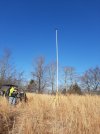I had a similar situation a week ago here in the UP of Michigan. I had to locate a corner in a not so nice a location that I never wanted to go back to again.
I set up my base (T3 with 35 w radio) and clawed my way through brushy ravines to the 1/4 corner I needed to locate. When I got there, I had no radio link. No problem, I had contingencies. I had a Topcon Hiper Plus running on a known point a couple miles away that I could post process with Post-Processing software to, along with the T3 base. I set up the LS and ran about an hour of WAAS float. The area around the corner was not that thick so I thought I was good. Then I discovered that my Topcon Base had a hiccup and thought it was 1988. No problem, I would DPOS my T3 base and Post-Process from that to the corner and also DPOS the corner session as a check. Again, everything failed. As luck would have it, all the CORS stations within a fifty miles were down that day. (October 5). After reading this post, I tried the procedure described by Nate. Again, no luck. I got a "Failed (No solution for this vector.) Is there anything left to try, or was October 5th just the GPS day from hell?

